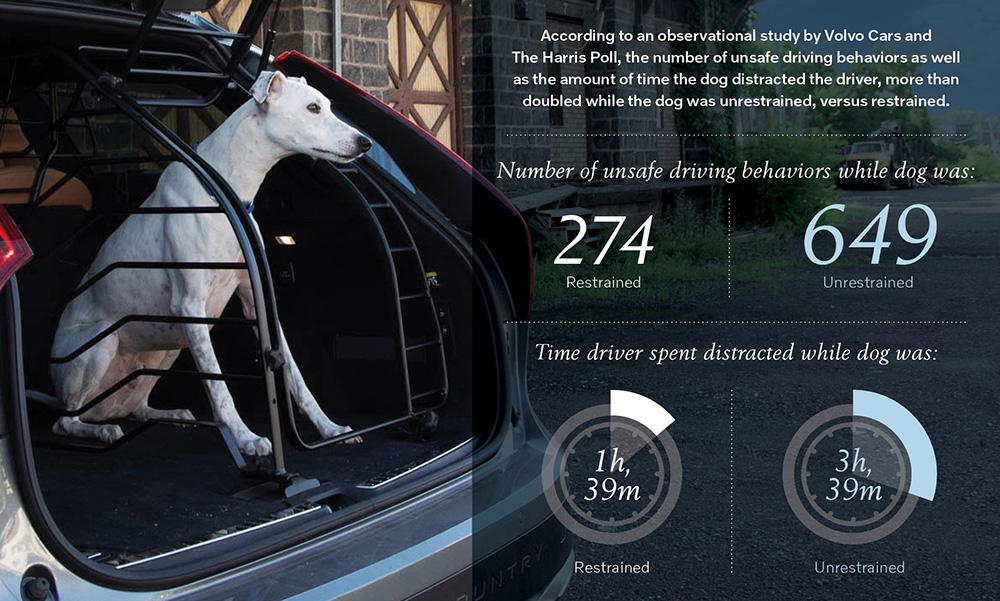A new study from Volvo Car USA and The Harris Poll revealed that allowing pets to roam unrestrained while driving led to significantly more unsafe driving behaviors, more time distracted and increased stress on both drivers and their four-legged friends.
While pets are now ingrained as essential members of the family, many pet owners aren’t keeping their safety in mind when driving with them. Volvo Reports: Keeping Pets Safe on the Road is highlighted by a unique observational study on how pet restraints affect the driving experience.
Volvo and The Harris Poll followed 15 drivers and their dogs for more than 30 hours on the road, to examine how driving with an unrestrained pet affected driving behavior vs. when an owner used restraints (e.g. pet seat belts, harnesses, crates, carriers). With pets allowed to roam freely, we found:
· Unsafe driving behaviors more than doubled
o 649 instances while unrestrained vs. 274 while restrained
o Includes climbing on a driver’s lap or hanging their head out the window
· Time drivers were distracted more than doubled
o 3 hr. 39 min. unrestrained vs. 1 hr. 39 min. restrained
o Includes dogs jumping from seat to seat or taking drivers’ eyes off the road
· Stress on both drivers and pups increased
o Heart rates were likely to increase for people and pets
o Unrestrained dogs measured a heart rate 7 beats per minute faster
o Drivers felt calmer when dogs were buckled in, with heart rates dropping as much as 28 and 34 beats per minute
The study further illustrates the dangers to all passengers, human and canine, when drivers do not restrain their dogs. This is echoed by internationally renowned veterinarian Dr. Elisa Mazzaferro, Staff Criticalist, Cornell University Veterinary Specialists. Dr. Mazzaferro is an expert in emergency and critical care of animals.
📖 Lire aussi :
“While pets roaming around the car can be cute and convenient, it poses serious risk for both drivers and their pets, both in terms of causing distractions and increasing the chances of serious injury in the event of an accident,” said Dr. Mazzaferro. “Unfortunately, in my field, we see the potential devastating consequences regularly, many of which can avoided by simply ensuring our animals are safely secured.”
Volvo Cars is the leading vehicle manufacturer to develop safety accessories for pets that directly tie into the safety system of the car. This integration is critical to ensuring all safety features work together to protect all occupants. These accessories include a Dog Harness, Load Compartment Divider, Dog Gate and Protective Steel Grille.
The report also built on last year’s inaugural Volvo Report in exploring the unique relationship between Americans, their pets and their cars. Some additional new findings include:
· Millennials still lead the way in pet pampering
o More than half would spend $50 or more on a birthday party for their pet
o 1 in 3 would pay more than $100 for doggy day care (36%), designer clothes (33%) and pet Fitbits (32%)
o 4 in 10 would take a “paw-ternity” leave from work if they got a new pet
· Americans want to travel with their pets, but are anxious about their safety
o Half of millennials would rather go on a road trip with their dog than their family (vs. 39% of all respondents)
o 4 in 10 millennials choose a weekend getaway with their dog than their partner (vs. 28% of pet owners overall)
o 32% of pet owners have left a dog at home because they felt their car was not safe enough
o 77% of Americans say people don’t take vehicular dog safety seriously enough
This report, Volvo Reports: Keeping Pets Safe on the Road, is the latest in a series of Volvo Reports from Volvo Car USA and The Harris Poll designed to uncover insights into the American opinion across four core themes: design, safety, technology and environment.

